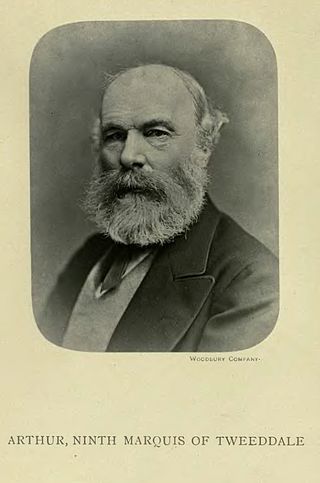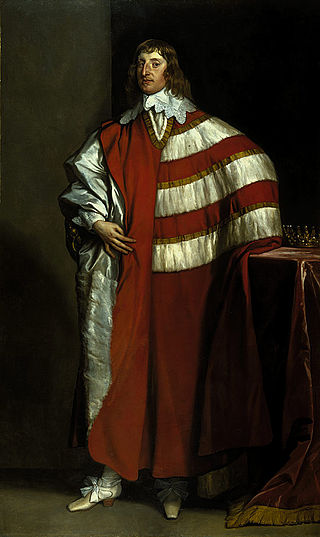Related Research Articles

Marquess of Tweeddale is a title of the Peerage of Scotland, created in 1694 for the 2nd Earl of Tweeddale. Lord Tweeddale holds the subsidiary titles of Earl of Tweeddale, Earl of Gifford (1694), Viscount of Walden (1694), Lord Hay of Yester (1488), and Baron Tweeddale, of Yester in the County of Haddington (1881), all but the last in the Peerage of Scotland. As Baron Tweeddale in the Peerage of the United Kingdom, Lord Tweeddale sat between 1881 and 1963 in the House of Lords. The Marquess's eldest son uses Viscount Walden as a courtesy title.

Colonel Arthur Hay, 9th Marquess of Tweeddale,, known before 1862 as Lord Arthur Hay and between 1862 and 1876 as Viscount Walden, was a Scottish soldier and ornithologist.

Field Marshal George Hay, 8th Marquess of Tweeddale, was a British soldier and administrator. He served as a staff officer in the Peninsular War under Arthur Wellesley and was with Wellesley at the Second Battle of Porto when they crossed the Douro river and routed Marshal Soult's French troops in Porto. Hay also saw action at the Battle of Bussaco and at the Battle of Vitoria. He later served in the War of 1812 and commanded the 100th Regiment of Foot at the Battle of Chippawa when he was taken prisoner of war. He went on to become governor of Madras and, at the same time, Commander-in-Chief of the Madras Army, in which role he restored the discipline of the army, which had been allowed to fall into a relaxed state.

Alexander Seton, 1st Earl of Dunfermline (1555–1622) was a Scottish lawyer, judge and politician. He served as Lord President of the Court of Session from 1598 to 1604, Lord Chancellor of Scotland from 1604 to 1622 and as a Lord High Commissioner to the Parliament of Scotland.

Charles Seton, 2nd Earl of Dunfermline PC, styled Lord Fyvie until the death of his father in 1622, was a Scottish peer.

James Hamilton, 1st Earl of Arran and 2nd Lord Hamilton was a Scottish nobleman, naval commander and first cousin of James IV of Scotland. He also served as the 9th Lord High Admiral of Scotland.
Hay is an English and Scottish surname, shortened from the Scoto-Norman de la Haye. A common variation is Hayes, and to a lesser degree Haynes, Haines, or Hughes. Notable people with the surname include:

Yester Castle is a ruined castle, located 1+1⁄2 miles southeast of the village of Gifford in East Lothian, Scotland. The only remaining complete structure is the subterranean Goblin Ha' or Hobgoblin Ha' . It is a Scheduled Ancient Monument, recorded as such by the Royal Commission on the Ancient and Historical Monuments of Scotland.

George Hay, Earl of Gifford was a British Liberal Party politician.
John Hay, 1st Lord Hay of Yester is the ancestor of the Marquesses of Tweeddale. He was created a Lord of Parliament on 29 January 1488 by James III of Scotland.
William Douglas, 2nd Earl of Angus was a Scottish nobleman and soldier. The son of George Douglas, 1st Earl of Angus and Princess Mary of Scotland, he was a grandson of King Robert III.
The Broun Baronets are a branch of the ancient Broun of Colstoun family whose estate near Haddington, East Lothian, remains to this day in the possession of a cadet family.

Yester Parish Church is a church of the Church of Scotland in the village of Gifford, East Lothian, Scotland. The village forms part of Yester, Bolton and Saltoun parish, and is a linked charge with Humbie Parish Church.

Yester House is an early 18th-century mansion near Gifford in East Lothian, Scotland. It was the home of the Hay family, later Marquesses of Tweeddale, from the 15th century until the late 1960s. Construction of the present house began in 1699, and continued well into the 18th century in a series of building phases. It is now protected as a category A listed building, and the grounds of the house are included in the Inventory of Gardens and Designed Landscapes in Scotland, the national listing of significant gardens.

William Montagu Hay, 10th Marquess of Tweeddale, KT, DL, known before 1878 as Lord William Hay or Lord William Montagu Hay, was a Scottish landowner, peer and politician. He was born at Yester House, near Gifford, East Lothian, and served in British India as a member of the Bengal Civil Service and later as a Liberal Member of Parliament.

William Hay, 1st Earl of Erroll was a Scottish peer. He was the first Earl of Erroll and the second Lord Hay of Erroll.
William George Montagu Hay, 11th Marquess of Tweeddale JP was a Scottish aristocrat, land owner and soldier.

James Hay, 7th Lord Hay of Yester (1564-1609) was a Scottish landowner and courtier.
William Hay, 6th Lord Hay of Yester was a Scottish nobleman and courtier.
John Hay, 1st Earl of Tweeddale (1593–1653) was a Scottish aristocrat.
References
- ↑ "Lord Yester (lyrics) by Weir/Williamson - PernilleQuigg.com". www.pernillequigg.com.